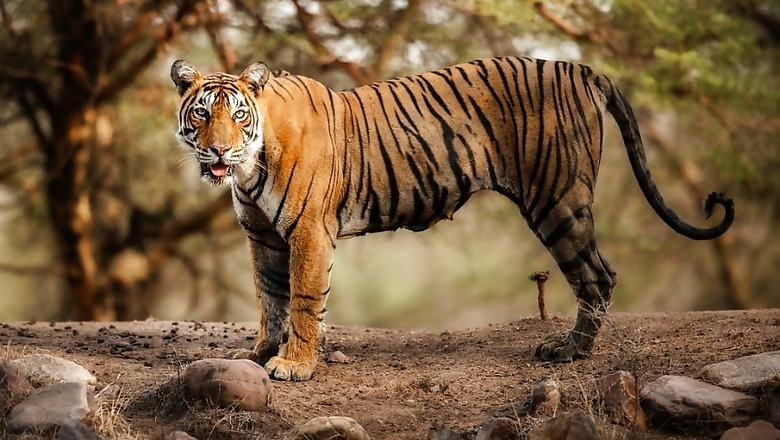
views
Suggesting a “paradigm shift” in the approach to “indiscriminately (double) tiger numbers” to move towards “prioritising conservation of naturally occurring diversity amongst tigers” in order to “retain their full evolutionary potential”, a study by scientists of the Wildlife Institute of India has turned conventional wisdom in the conservation of tigers on its head.
The study identifies three tiger population clusters in India: the north-eastern tigers which are unique, a combined cluster of tigers living in the Western Ghats, western India and the Terai region, and a mixed-cluster in central India. “Tigers from the southern Western Ghats, Odisha and Valmiki showed unique genetic signatures” which wasn’t found in other groups, while the study also showed “the genetic separation of the North-Eastern tigers from the rest of the Indian tiger populations.”
On the basis of this, the study suggests the need for reintroduction measures to take into account the broad genetic clusters. In particular, it underlines the need for restoring and managing habitat corridors in fragmented central Indian populations in order to allow the species to “retain their full evolutionary potential while managing to mitigate anthropogenic induced genetic structuring”.
The study points out that genetic diversity is a result of “behavioural, morphological and physiological plasticity” and is an ingredient for the evolutionary process to operate. Tigers, inhabiting diverse habitats ranging from the cold deserts of Siberia to the mangrove forests of Sundarbans, exhibit high levels of plasticity and the study argues “it would be important to first understand the underlying genetic diversity of their populations caused due to these adaptations as well as natural historical events” before planning conservation strategies.
The study uses a non-invasive method by sampling faecal samples or scat of tigers from across its range in India, including, for the first time the ‘snow’ tigers of the Dibang valley in Arunachal Pradesh’s Namdapha tiger reserve.
North-eastern tigers are genetically unique
The results from the study clearly showed the “the genetic separation of the North-Eastern tigers from the rest of the Indian tiger populations” and highlights “the importance of North-East tigers due to their divergent genetic constitution.”
The study further points to a subdivision in the structure of the highland populations of Dibang and Namdapha, as being different from the population present in the plains of north-Bengal and Assam at the Kaziranga-Manas-Buxa complex. “A plausible reason for the distinction of North-Eastern tigers from the rest of the Indian tigers could be due to sharing of genetic material with the Indochinese tiger population (Panthera tigris corbetti) which borders the north-eastern states,” the study suggests.
But, why does this matter? The study warns, “Given the current results, combined with the low density and small tiger numbers in the north-eastern hill region, the North-Eastern tiger populations merit the status of a special population unit of high conservation value.” It adds that, in terms of forest management, two separate sub-clusters of the north-eastern landscape needs to be maintained: the hills and the floodplains and foothills.
The north-eastern landscape, amongst the most diverse in the world, is also among the most threatened. Take for instance, the case of the Buxa Tiger Reserve — one of the three tigers reserves in India without any tigers, found the nationwide tiger census conducted by the National Tiger Conservation Authority (NTCA). The 2018 census noted that the population declines in Nameri (Assam) and Pakke (Arunachal Pradesh) and did not record any tigers in Buxa (Bengal), Palamau (Jharkhand) and Dampa (Mizoram). The NTCA report cautioned that populations in the Northeast hills and Odisha remain “critically vulnerable” and need immediate attention.
An official of the NTCA said, “The problem is that the tigers in the north-east have fallen prey to skewed development priorities. In the case of Madhya Pradesh, for instance, there has been a surge in tiger tourism that has given employment and communities have become stakeholders. This isn’t the case in Buxa or Manas. Here, people and tigers fight over the same resources — land and forest. There is, inevitably, only one winner.”
Genetic diversity as a “baseline” for conservation
The study argues that “the underlying genetic diversity” of the tiger population in India, can serve “as an important baseline for informed conservation practice.” In other words, this allows conservationists to “to identify genetic clusters, populations harbouring unique diversity and subsequently those in need of significant conservation attention.”
This information can then guide the management and planning of tiger reintroductions and sourcing of tigers to supplement depleting populations.
Take for instance, the tigers of Simlipal-Palamu, where there are low numbers and yet harbour unique diversity which is “currently under-represented and not prioritized for conservation investments.” The only population where melanistic tigers are currently recorded, in this pocket — the study found — “separate out as a unique cluster, apart from some similarity with Palamau tigers and distantly with Bandhavgarh.”
“This genetic uniqueness and critical status puts the Odisha tigers on a priority for conservation investment. These depleted populations could potentially be supplemented from Bandhavgarh, which is genetically the closest source population,” it suggested, while adding, “Given the small number of tigers in all of these unique populations, conservation efforts should target these on a priority, so as to preserve tiger genetic diversity in its entirety.”
It also noted that habitat fragmentation caused by humans is a major cause for concern across tiger landscapes, especially so within the landscapes of central India and southern Western Ghats. “Habitat restoration and management within identified corridors are essential elements for managing these populations in a meta-population framework for long-term persistence of tigers here,” it said.
The Central Indian tigers were found to be the most diverse and encompassed diversity from across most Indian tiger populations, hence investing conservation efforts for these tigers would “give maximum returns in terms of preserving tiger genetic diversity” and “enabling habitat connectivity between populations to maintain large meta-populations is essential.”




















Comments
0 comment